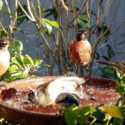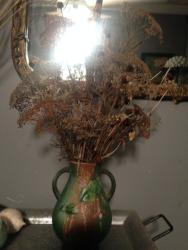Caroline you are so RIGHT! The longer I garden the more I realize to be successful you have to mimic nature. I let everything drop in the fall and leave it alone. Plants were made to feed themselves. Dropped leaves, fruit, or nuts. Picking everything up is bad for the plant that made it and those that eat it. In the spring, I start cleaning up for the new growth. I get so many comments equal to this...so glad to see you are going to garden again after last fall I thought you might have given it up. Our mindsets of "neat" is natures worst enemy.
A sad comment is the #1 crop grown in North America can reasonably be considered to be grass, between lawns, sod farms, grass seed, etc. That is a lot of natural resources devoted to something that is non-life substaining. Even when you have a nice lawn there are things you can do. Let the dandylions come up in spring, put out some yellow flowers. Then instead of spraying get a dandylion digger and pop out. Pollinators will thank you for the early spring treat and so will your grass. In an area where St. Augustine experienced many diseases, mine never did. I was aerating it every spring when getting the weeds out. Not everything needs an immediate spray.
Tap into your natural procrastinator. Look at the aphids, do nothing, see if the lady bugs come. See a weed bloom. Watch for butterflies or bees. The ladybugs come later than aphids...ladybugs need the food supply to already be established for their larvae. Once your flowers are blooming, you can take the weeds out. Then tell yourself I learned patience, I am not a procrastinator and I hopefully made the world a better place.

If it was not bad enough that we cleared so much natural landscape for cropland, what are we now doing? What is happening to some cropland is a disgrace. A huge quantity of prime cropland is being paved over. Nice, flat and already cleared so it is cheaper to build on. How true is that song they paved paradise and put up a parking lot. In the event of a disaster...how realistic is it to think you could reclaim that good cropland? Then even if you could would it be any good or polluted?
May everyone be blessed to find joy in nature!



